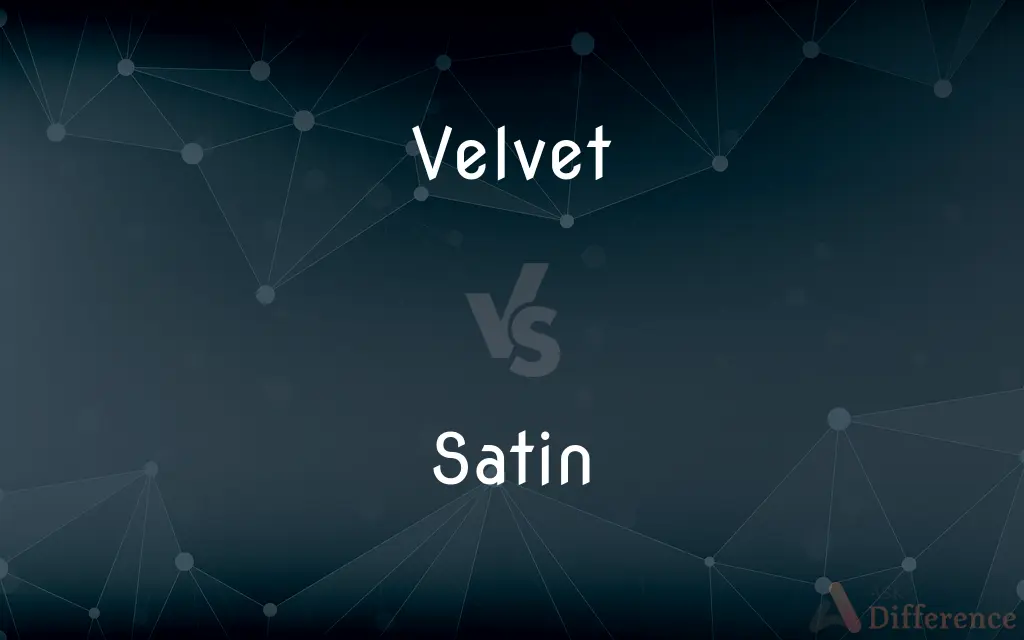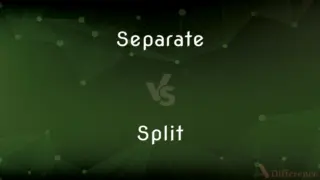Velvet vs. Satin — What's the Difference?
By Tayyaba Rehman & Urooj Arif — Updated on March 21, 2024
Velvet is known for its luxurious depth and soft texture due to its dense pile, ideal for warmth and richness, whereas satin is sleek, smooth, and glossy, offering a cool feel and elegant sheen.

Difference Between Velvet and Satin
Table of Contents
ADVERTISEMENT
Key Differences
Velvet, characterized by its soft, dense pile made from various fibers, offers a unique texture and visual depth that conveys luxury and comfort. On the other hand, satin is woven to create a smooth, glossy surface that reflects light, emphasizing elegance and smoothness.
The production of velvet involves creating a pile, often through a process that cuts across woven threads, giving it a distinctive soft feel and appearance. Whereas satin's production focuses on a weave that allows threads to float, resulting in its characteristic smooth and shiny surface.
Velvet is often preferred in colder climates or for winter fashion and home decor due to its warmth and texture. Conversely, satin, with its cool touch, is favored in warmer climates and for evening wear, lingerie, and bedding, highlighting its versatility across different temperatures and uses.
In terms of care, velvet requires special attention to maintain its texture and appearance, including professional cleaning or careful hand washing. Satin, while also delicate, often allows for easier maintenance and can sometimes be machine washed, depending on the fabric blend.
Culturally, velvet has been associated with nobility and luxury throughout history, used in royal and ceremonial garments. Satin, while also luxurious, has a more diverse range of uses in fashion, from wedding dresses to everyday items, showcasing its adaptability in both high-end and practical applications.
ADVERTISEMENT
Comparison Chart
Texture
Soft, dense pile
Smooth, glossy
Composition
Made from silk, cotton, or synthetic fibers
Primarily silk or synthetic fibers
Climate Suitability
Better for cold climates or winter use
Preferred in warmer climates or for nightwear
Care Instructions
Requires special care, often professional cleaning
Easier to maintain, some varieties machine washable
Cultural Significance
Associated with nobility and luxury, used in royal garments
Used widely in fashion, from high-end to practical applications
Compare with Definitions
Velvet
A fabric with a thick, soft pile.
The velvet dress felt luxurious against her skin.
Satin
Common in evening wear and lingerie.
She chose a satin slip dress for her date night.
Velvet
Symbolizes luxury and comfort.
The king's velvet robe was a symbol of his status.
Satin
Preferred for its sleek feel.
Satin sheets are favored for their cool touch.
Velvet
Requires careful maintenance.
He took his velvet blazer to be professionally cleaned.
Satin
Versatile in use and appearance.
Satin ribbons are popular in both crafts and fashion.
Velvet
Known for its depth and texture.
The red velvet curtain added a rich look to the room.
Satin
Often easier to care for.
Her satin blouse was machine washable, making it a practical choice.
Velvet
Used in upholstery and garments.
Velvet sofas are synonymous with elegance.
Satin
A fabric with a smooth, glossy surface.
Her satin gown shimmered under the gala lights.
Velvet
Velvet is a type of woven tufted fabric in which the cut threads are evenly distributed, with a short dense pile, giving it a distinctive soft feel. By extension, the word velvety means "smooth like velvet".
Satin
A satin weave is a type of fabric weave that produces a characteristically glossy, smooth or lustrous material, typically with a glossy top surface and a dull back. It is one of three fundamental types of textile weaves alongside plain weave and twill weave.
Velvet
A closely woven fabric of silk, cotton, or nylon, that has a thick short pile on one side
An armchair covered in velvet
Red velvet curtains
Satin
A smooth, often silk fabric that is woven with a glossy face and a dull back.
Velvet
A soft fabric having a smooth, dense pile and a plain underside.
Satin
A garment made of this fabric.
Velvet
Something suggesting the smooth surface of velvet.
Satin
A kind of paint that dries to a smooth shiny finish.
Velvet
Smoothness; softness.
Satin
Made of or covered with satin.
Velvet
The soft, furry covering on the developing antlers of deer.
Satin
Glossy, sleek, and smooth.
Velvet
The winnings of a gambler.
Satin
A cloth woven from silk, nylon or polyester with a glossy surface and a dull back. (The same weaving technique applied to cotton produces cloth termed sateen).
Velvet
A profit or gain beyond what is expected or due.
Satin
Semigloss.
Satin paint
Velvet
New England See milkshake.
Satin
(transitive) To make (paper, silver, etc.) smooth and glossy like satin.
Velvet
A closely woven fabric (originally of silk, now also of cotton or man-made fibres) with a thick short pile on one side.
Satin
A silk cloth, of a thick, close texture, and overshot woof, which has a glossy surface.
Cloths of gold and satins rich of hue.
Velvet
Very fine fur, including the skin and fur on a deer's antlers.
Satin
A smooth fabric of silk or rayon; has a glossy face and a dull back
Velvet
A female chinchilla; a sow.
Velvet
The drug dextromethorphan.
Velvet
Money acquired by gambling.
Velvet
To cover with velvet or with a covering of a similar texture.
Velvet
(cooking) To coat raw meat in starch, then in oil, preparatory to frying.
Velvet
To remove the velvet from a deer's antlers.
Velvet
To soften; to mitigate.
Velvet
(of a cat's claws) to retract.
Velvet
Made of velvet.
Velvet
Soft and delicate, like velvet; velvety.
Velvet
(politics) peaceful, carried out without violence; especially as pertaining to the peaceful breakup of Czechoslovakia.
Velvet
A silk fabric, having a short, close nap of erect threads. Inferior qualities are made with a silk pile on a cotton or linen back, or with other soft fibers such as nylon, acetate, or rayon.
Velvet
The soft and highly vascular deciduous skin which envelops and nourishes the antlers of deer during their rapid growth.
Velvet
Something likened to velvet{1} in being soft or luxurious; as, a lawn of velvet.
Velvet
Made of velvet; soft and delicate, like velvet; velvety.
Velvet
To pain velvet.
Velvet
To make like, or cover with, velvet.
Velvet
A silky densely piled fabric with a plain back
Velvet
Smooth and soft to sight or hearing or touch or taste
Velvet
Resembling velvet in having a smooth soft surface
Common Curiosities
Can velvet and satin be used together in fashion?
Yes, combining them can add contrasting textures and luxury to fashion pieces.
What is the main difference between velvet and satin?
The main difference is texture: velvet is soft and plush due to its pile, while satin is smooth and glossy.
How should velvet be cared for?
Velvet requires careful maintenance, often needing professional cleaning to preserve its texture.
Is satin a good choice for bedding?
Yes, satin bedding is popular for its smoothness and cool feel, often preferred in warmer climates.
Is satin suitable for outdoor clothing?
While satin can be used in outerwear, it is more commonly associated with evening wear and special occasions due to its delicate nature.
Can both fabrics be made from synthetic materials?
Yes, both velvet and satin can be made from synthetic fibers, offering more affordable and care-friendly options.
Are velvet and satin suitable for summer clothing?
Generally, satin is more suitable for summer due to its cool touch, while velvet is favored in colder months.
Do velvet and satin come in various colors?
Both fabrics are available in a wide range of colors, enhancing their appeal for different uses and preferences.
What are the environmental impacts of velvet and satin production?
The environmental impact varies depending on the fibers used, with synthetic fibers generally having a higher environmental footprint than natural ones.
Are there any cultural differences in the use of velvet and satin?
Yes, cultural preferences can influence the use of these fabrics, with velvet often associated with luxury and formality, and satin used more broadly in fashion.
Why is velvet considered luxurious?
Its rich texture, depth, and the complex process required to make it contribute to its luxurious reputation.
Can satin be used for upholstery?
While not as common as velvet for upholstery, satin can be used for decorative pieces that require a sleek appearance.
Can velvet be used for casual wear?
While traditionally associated with luxury, modern fashion trends have incorporated velvet into casual wear.
Why is satin a popular choice for wedding dresses?
Its smooth, glossy surface offers an elegant sheen that complements the formal and celebratory nature of weddings.
How do the costs of velvet and satin compare?
The cost can vary widely based on the fiber content, with pure silk versions of both being more expensive than synthetic alternatives.
Share Your Discovery

Previous Comparison
Separate vs. Split
Next Comparison
Record vs. ReportAuthor Spotlight
Written by
Tayyaba RehmanTayyaba Rehman is a distinguished writer, currently serving as a primary contributor to askdifference.com. As a researcher in semantics and etymology, Tayyaba's passion for the complexity of languages and their distinctions has found a perfect home on the platform. Tayyaba delves into the intricacies of language, distinguishing between commonly confused words and phrases, thereby providing clarity for readers worldwide.
Co-written by
Urooj ArifUrooj is a skilled content writer at Ask Difference, known for her exceptional ability to simplify complex topics into engaging and informative content. With a passion for research and a flair for clear, concise writing, she consistently delivers articles that resonate with our diverse audience.














































